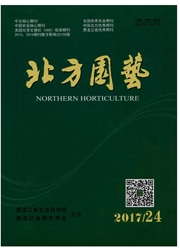

 中文摘要:
中文摘要:
以黑龙江省6个香鳞毛蕨主产地(五大连池二池、五大连池三池、老黑山、镜泊湖、民俗村、镜泊峡谷)土壤为试材,利用常规实验室分析法和Biolog-Eco微平板法,研究了黑龙江省香鳞毛蕨产地土壤微生物的群落特征。对土壤养分、多样性指数及不同生境土壤对碳源的利用情况进行分析。结果表明:1)土壤有机质、全氮含量表现为老黑山最低,其他香鳞毛蕨产地间差异不显著;土壤碱解氮含量表现为五大连池三池〉五大连池二池〉民俗村、老黑山、镜泊湖、镜泊峡谷;土壤全磷含量表现为五大连池三池、五大连池二池最低,其他香鳞毛蕨产地间差异不显著;土壤速效磷含量表现为镜泊湖火山群样地较低,五大连池火山群样地较高;全钾含量表现为镜泊湖、老黑山〉五大连池二池、民俗村、镜泊峡谷、五大连池三池;速效钾含量表现为镜泊湖〉民俗村〉老黑山、镜泊峡谷、五大连池三池〉五大连池二池;缓效钾含量表现为老黑山〉五大连池三池〉五大连池二池〉镜泊湖、镜泊峡谷〉民俗村;pH介于5.38~6.56,且不同样地pH变化范围较小,变异系数为8.99%。2)各产地的土壤微生物群落功能多样性指数表现为镜泊湖〉镜泊峡谷、民俗村〉老黑山〉五大连池二池、五大连池三池。3)不同香鳞毛蕨产地土壤微生物碳源利用的主成分分析(PCA)表明糖类、氨基酸类、多聚物类、羧酸类、胺类和酚酸类碳源是香鳞毛蕨土壤微生物功能多样性差异的敏感碳源。4)聚类分析表明,五大连池二池和三池的土壤微生物具有相近的碳源利用模式,镜泊湖和镜泊峡谷土壤微生物的碳源利用模式相近,而老黑山和民俗村土壤微生物的碳源利用模式相近。
 英文摘要:
英文摘要:
The six soil samples from the main Dryopteris fragrans producing areas of Heilongjiang Province (the second pool of Wudalianchi, the third pool of Wudalianchi, Laoheishan Volcano,Jingpo Lake,Folk Village, Jingbo Canyon) were studied using routine laboratory analysis and Biolog-Eco micro plate method to the characteristics of soil microbial communities. The soil nutrients, diversity index and the utilization of carbon sources in different habitats were analyzed. The results showed that:l) the soil organic matter content showed that Laoheishan Volcano was the lowest and there was no significant differences among other D. fragrans producing areas; the soil alkali hydrolyzable nitrogen content showed that the third pool of Wudalianchi 〉 the second pool of Wudalianchi 〉 Folk Village, Laoheishan Volcano,Jingpo Lake and Jingbo Canyom the soil phosphorus content showed that the second and third pool of Wudalianchi was the lowest and there was no significant differences among other D. fragrans producing areas〉 the soil available phosphorus content showed that Jingpo Lake Volcano Group plots were lower and the Wudalianchi Volcano Group plots were higher,the total potassium content showed that Jingpo Lake and Laoheishan Volcano 〉 the second pool of Wudalianchi, three pool, Folk Village and Jingbo Canyom the available potassium content showed that Jingpo Lake 〉 Folk Village 〉 Laoheishan Volcano,Jingbo Canyon and the third pool of Wudalianchi 〉 the second pool of Wudalianchi〉 the slowly available potassium content showed that Laoheishan Volcano 〉 the third pool of Wudalianchi 〉 the second pool of Wudalianchi 〉 Jingpo Lake and Jingbo Canyon 〉 Folk Village 〉 the pH value among these D. fragrans producing areas ranged from 5.38 to 6. 56,and the variation range was not the same, and the variation coefficient was 8. 99.2) the soil microbial community functional diversity index of different places showed that Jingpo Lake 〉 Jingbo Canyon and Folk Village 〉 Laoheishan Volcano 〉 the second and
 同期刊论文项目
同期刊论文项目
 同项目期刊论文
同项目期刊论文
 期刊信息
期刊信息
